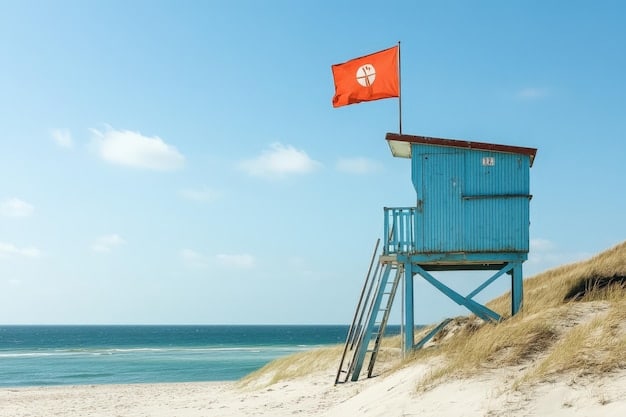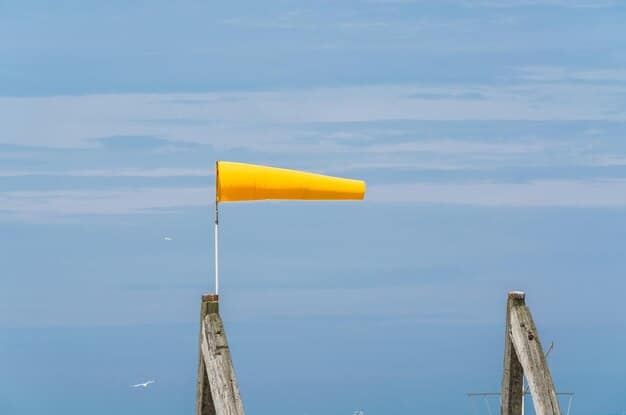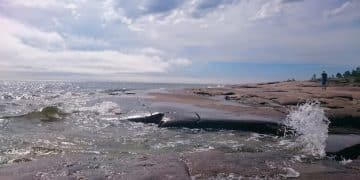Beach Flag Warning Systems: Guide to US Water Safety

Navigating US waters safely requires understanding beach flag warning systems, which standardize visual signals to communicate immediate hazards like rip currents, dangerous marine life, or polluted conditions, offering crucial guidance for swimmers and beachgoers alike.
There’s an undeniable allure to the ocean, its vastness and rhythmic waves inviting millions to its shores each year. Yet, beneath its tranquil surface, hidden dangers can lurk. For anyone venturing into coastal waters, particularly throughout the United States, understanding the silent language of beach flags is not just advisable—it’s absolutely essential for safety. This guide aims at thoroughly Decoding Beach Flag Warning Systems: A Guide to Staying Safe in US Waters, ensuring your next beach trip is memorable for all the right reasons.
The Universal Language of Beach Flags: A US Perspective
Across the diverse coastlines of the United States, beach flag warning systems serve as a critical, universally recognized safety mechanism. These flags are not mere decorations; they are vital communication tools, relaying immediate information about prevailing water conditions and potential hazards. Understanding what each color signifies is the first and most crucial step towards ensuring a safe and enjoyable beach experience for everyone.
While minor regional variations might exist, the core principles of US beach flag systems are largely standardized, often aligning with guidelines set by organizations like the United States Lifesaving Association (USLA). These guidelines promote consistency, which is paramount when beachgoers may visit different coastal areas.
Why Standardized Flags Matter
A unified system minimizes confusion and ensures that critical safety information is understood instantly, regardless of where you are along the extensive US coastline. This standardization is particularly important for tourists and vacationers who may not be familiar with local conditions or regulations.
- Immediate Communication: Flags provide immediate visual cues about water hazards, often more quickly and broadly than verbal announcements.
- Non-Verbal Understanding: They transcend language barriers, making them effective for all beach visitors.
- Proactive Safety: By posting flags, authorities alert swimmers to conditions before they enter the water, preventing incidents rather than reacting to them.
The flags are typically flown from prominent locations such as lifeguard stands, designated flagpoles, or near beach access points. Regular monitoring by lifeguards and beach patrol ensures that the flags accurately reflect the current conditions, which can change rapidly due to weather patterns, tides, and other environmental factors.
Ultimately, the presence of a clear, standardized beach flag system underscores a fundamental commitment to public safety. It empowers individuals to make informed decisions about entering the water and provides lifeguards with a powerful tool to manage risk effectively.
Decoding Individual Flag Colors and Their Meanings
Each flag color carries a specific message, escalating in urgency as the potential danger increases. Knowing these meanings is paramount for personal safety. This section breaks down the most common flag colors you’ll encounter on US beaches, offering detailed explanations and practical advice for each.

Green Flag: Low Hazard
A green flag indicates relatively calm conditions. This typically means that the water is safe for swimming, and there are no unusual hazards present, such as strong currents or dangerous marine life. While a green flag suggests good conditions, it’s important to remember that inherent risks still exist in any natural water body. Always swim with caution and never alone, even when conditions appear ideal.
Yellow Flag: Medium Hazard
When a yellow flag is flying, it signals a moderate risk level. This might be due to slightly stronger currents, choppy waters, or other conditions that require increased vigilance. Swimmers are advised to exercise caution, stay close to shore, and always remain within the designated swimming areas monitored by lifeguards. If you are not a strong swimmer, it may be best to avoid entering the water during yellow flag conditions.
- Increased Caution: Be mindful of your surroundings and the strength of the waves.
- Stay Shallow: Avoid deep waters and areas with strong undertows.
- Supervise Children Closely: Children and inexperienced swimmers need extra supervision.
A yellow flag often means that while swimming is permitted, it’s not without potential challenges. It’s a call for personal responsibility and heightened awareness.
Red Flag: High Hazard
A single red flag indicates high hazards, often signifying strong surf, dangerous currents, or other severe conditions. During red flag conditions, swimming is highly discouraged. Entering the water under a red flag significantly increases the risk of injury or drowning. Lifeguards often actively discourage or prohibit swimming during these times.
It’s crucial to respect the red flag warning, even if the water looks deceptively calm from the shore. Rip currents, for instance, can be invisible until you’re caught in one, and a red flag often signals their presence.
Double Red Flags: Water Closed to Public
The most serious warning, double red flags, means the water is closed to the public. Under no circumstances should anyone enter the water when double red flags are flying. This level of warning is reserved for extreme dangers, such as severe weather events (e.g., hurricanes, tropical storms), dangerous marine life surges, or catastrophic water quality issues. Disregarding double red flags can result in fines, severe injury, or death.
Beach patrols and law enforcement take double red flag warnings very seriously, and violations can lead to legal consequences.
Purple Flag: Dangerous Marine Life
A purple flag indicates the presence of dangerous marine life. This is a specific warning that does not necessarily relate to the water’s currents or physical conditions. It could signify jellyfish, stingrays, sharks, or other potentially harmful aquatic animals. While swimming might otherwise be permitted, caution is advised, and it’s recommended to stay out of the water if you have sensitivities or allergies, or if particularly dangerous species have been sighted.
Orange Wind Sock: Offshore Wind Warning
Though not a flag, an orange wind sock is another important warning signal often displayed on beaches. It indicates strong offshore winds, which can be dangerous for various reasons. Offshore winds can rapidly carry inflatable rafts, paddleboards, and even young swimmers far from shore, making it difficult to return. Individuals using flotation devices should be especially cautious. This warning is distinct from water current warnings but is equally important for certain activities.
Understanding these distinct signals empowers beachgoers to make informed decisions and act responsibly, aligning their activities with the true safety level of the water at any given moment.
Common Hazards Signaled by Beach Flags
Beach flags are direct responses to tangible threats. These threats are dynamic, influenced by environmental factors, and can pose significant risks to swimmers and beachgoers. Understanding the primary hazards that trigger flag warnings can deepen your appreciation for their importance and reinforce safe behaviors.
Rip Currents: The Silent Danger
Rip currents are perhaps the most frequently cited reason for red flag warnings and are responsible for the vast majority of lifeguard rescues. These narrow, powerful channels of water flow quickly away from the shore, pulling swimmers out to sea. They often appear as a break in the wave pattern, a line of foam, or discolored water.
- Appearance: Look for a channel of churning, choppy water, an area of noticeable calm with waves breaking on either side, or a line of foam or debris moving steadily offshore.
- Action if Caught: If caught in a rip current, remain calm. Do not try to swim directly against it. Instead, swim parallel to the shore until you are out of the current, then swim back to the beach at an angle. If you cannot escape, float or calmly tread water and wave for help.
Many beach fatalities occur when swimmers exhaust themselves trying to fight a rip current directly. Lifeguards are trained to spot and deal with rip currents, and their presence is often reflected in current flag warnings.
High Surf and Strong Waves
Large waves and powerful surf can be incredibly dangerous, especially for inexperienced swimmers or those caught off guard. High surf can make it difficult to enter or exit the water safely, leading to injuries from being tossed about by waves or colliding with the seabed. Strong breaking waves can also create dangerous undertows that pull swimmers beneath the surface.
Red flags are frequently flown to warn of high surf conditions. Even if you consider yourself a strong swimmer, powerful waves can quickly become overwhelming and draining. It’s often best to admire the big waves from the sand.
Dangerous Marine Life Encounters
As indicated by a purple flag, various marine creatures can pose risks. These range from jellyfish that deliver stinging tentacles, to stingrays that can cause painful puncture wounds, and, less frequently, sharks.
While shark attacks are rare, purple flags or specific signage will be used if there’s a heightened presence. More commonly, jellyfish blooms can make swimming unpleasant or even dangerous, especially for individuals with allergies. Always heed purple flag warnings and consider avoiding the water if you have known sensitivities.
Water Quality Issues
Occasionally, beach flags (often red or double red, or sometimes a specific advisory sign) might be used to indicate water quality concerns. This could involve high levels of bacteria following heavy rainfall, sewage spills, or harmful algal blooms (like red tide). Swimming in contaminated water can lead to skin rashes, gastrointestinal illness, or other health problems.
Local health departments and environmental agencies monitor water quality, and beach flags are a quick way to communicate public health advisories.
Each of these hazards underscores why paying attention to beach flags—and respecting the warnings they convey—is an essential part of responsible beach behavior. Lifeguards and beach authorities are your best resource for understanding current conditions and their associated risks.
Lifeguards: Interpreters of the Flags and Guardians of the Coast
While beach flags are the visual signals, lifeguards are the human intelligence behind them. They are the eyes on the ocean, the trained professionals who assess conditions, interpret immediate threats, and ultimately decide which flags need to fly. Their role extends far beyond merely posting flags; they are vigilant guardians, educators, and first responders.
The Lifeguard’s Expertise
Lifeguards possess specialized knowledge and skills that are critical for beach safety. They undergo rigorous training in:
- Oceanography and Meteorology: Understanding wave patterns, tides, currents, and local weather phenomena.
- First Aid and CPR: Essential for responding to medical emergencies on the beach.
- Water Rescue Techniques: Proficient in various methods for retrieving swimmers in distress.
- Risk Assessment: Continuously evaluating the beach environment for potential hazards.
This expertise allows them to accurately determine conditions and select the appropriate flag warnings. They are constantly observing, adapting to changing conditions, and communicating those changes through the flag system.
Dynamic Condition Assessment
Beach conditions are rarely static. A beach that is calm in the morning can become treacherous by afternoon due to shifting winds, incoming tides, or distant weather systems. Lifeguards are trained to recognize these subtle changes and update flag warnings accordingly. This dynamic assessment is why it’s crucial to check the flags not just upon arrival, but periodically throughout your visit.
Beyond the flags, lifeguards are also a direct source of information. If you have questions about the water conditions, current hazards, or safe swimming areas, approach a lifeguard. They are there to help and provide guidance based on real-time observations.
Enforcing Safety Regulations
In addition to warning, lifeguards are often responsible for enforcing beach safety regulations. This could include advising swimmers to stay within designated areas, prohibiting certain activities during unsafe conditions, or even issuing citations for disregard of warnings, particularly under double red flag conditions.
Their presence alone acts as a deterrent to unsafe behavior and a rapid response unit in case of emergency. By respecting beach flags and following lifeguard instructions, you are not only ensuring your own safety but also assisting them in maintaining a safe environment for everyone.
In essence, lifeguards are the human element that brings the beach flag system to life. Their dedication, vigilance, and expertise are indispensable to coastal safety, making them your primary allies when visiting any US beach.
Best Practices for Beach Safety Beyond the Flags
Understanding and obeying beach flags is the cornerstone of water safety, but it’s part of a broader strategy for a safe beach outing. Several other best practices can significantly enhance your protection and enjoyment, ensuring a well-rounded approach to coastal recreation.
Swim Near a Lifeguard
This is arguably the most fundamental rule for beach safety. Even the strongest swimmers can encounter unexpected difficulties. Lifeguards are trained professionals who can spot trouble quickly and respond efficiently. Their presence vastly reduces the risk of drowning or serious injury.
Designated swimming areas are typically marked and are almost always where lifeguards are stationed. Avoid swimming in unsupervised areas, even if they appear calm.
Never Swim Alone
The buddy system is an age-old safety principle that applies perfectly to beach swimming. Having someone with you ensures that if you get into trouble, there’s another person who can either assist you or alert a lifeguard.
Learn How to Swim in Ocean Conditions
Ocean swimming differs significantly from pool swimming. Waves, currents, and variable depths introduce challenges not found in controlled environments. Consider taking lessons specifically designed for open water or ocean swimming if you are a novice or feel unsure about your abilities in dynamic conditions.
- Conserve Energy: Don’t fight currents directly; swim parallel to shore to escape.
- Understand Wave Action: Learn to dive under breaking waves or ride them safely.
- Buoyancy: Realize that saltwater offers more buoyancy than freshwater.
Monitor Children Closely
Children are especially vulnerable at the beach, and even a moment of distraction can lead to a dangerous situation. Designate a responsible adult to actively supervise children at all times, ideally from within arm’s reach for younger kids. Teach children about beach safety, including what the flags mean.
Heed Local Warnings and Signage
Beyond the flags, beaches often have additional signage providing specific local warnings. This could include information about protected marine areas, nesting zones for wildlife, or particular hazards like sudden drop-offs. Always take the time to read and understand these local advisories.
Protect Yourself from the Sun
While not a water hazard, sun exposure is a significant health concern at the beach. Use broad-spectrum sunscreen with a high SPF, wear protective clothing (like rash guards), sunglasses, and hats. Seek shade during peak sun hours (10 AM to 4 PM) and stay hydrated by drinking plenty of water.
By integrating these best practices with an informed understanding of beach flags, you create a comprehensive personal safety plan. A memorable beach day is a safe beach day, and prevention is always better than reaction.
Regional Variations and Specific US Challenges
While a general framework for beach flags exists across the US, some regional nuances and specific challenges unique to certain coastlines can affect how these systems are implemented and interpreted. Being aware of these regional differences can further enhance your preparedness.
Florida’s Specific System
Florida, with its extensive coastline and popularity as a beach destination, has one of the most visible and widely adopted flag systems, often including all the colors discussed (green, yellow, red, double red, purple). Some Florida beaches may also fly a blue flag for good environmental conditions, though this is less common nationally.
The state faces particular challenges with rip currents and sudden summer thunderstorms, making consistent flag posting and lifeguard presence crucial. Visitors to Florida’s beaches should be particularly vigilant about afternoon storms that can rapidly change water conditions and lead to lightning strikes.
California’s Diverse Coastline
California’s coastline features a mix of broad sandy beaches, rocky shores, and strong Pacific currents. While standard flags are used, California beaches often emphasize specific warnings related to:
- Cold Water: Even in summer, Pacific waters can be surprisingly cold, posing a risk of hypothermia for prolonged exposure.
- Strong Undertows: Powerful waves can create significant undertows, especially around jetties and piers.
- Coastal Erosion: Some areas may experience unstable cliffs or restricted access due to erosion.
Lifeguards along the California coast are highly trained to handle these specific conditions, and beach warning systems often incorporate more localized signage to address unique geological or environmental factors.
The Gulf Coast’s Unique Conditions
The Gulf Coast, from Texas to Florida, is known for its warm, shallow waters. However, it presents unique challenges:
- Marine Life: Warmer waters can mean a higher prevalence of jellyfish, stingrays, and occasionally even small sharks, leading to more frequent purple flag warnings.
- Tropical Systems: The Gulf is highly susceptible to tropical storms and hurricanes, which can necessitate extended periods of double red flag warnings and beach closures.
- Oil Spills: While rare, past events have shown the need for warnings related to water contamination, which would be covered by enhanced red or double red flags, or specific advisories.
Local authorities in these regions are adept at leveraging flag systems, often in conjunction with public address systems, to disseminate information rapidly during severe weather events.
Pacific Northwest and Northeastern Coasts
These regions feature colder waters and can experience different types of coastal hazards, such as:
- Hypothermia Risk: Due to colder water temperatures, even short exposures can be dangerous without proper wetsuits.
- Steep Drop-offs: Some beaches may have sudden, deep drop-offs close to shore.
- Rogue Waves: Unpredictable, exceptionally large waves can sometimes occur.
While the flag system remains consistent, the underlying reasons for red or yellow flags might stem from different meteorological or oceanic phenomena unique to these cooler, often more rugged coastlines.
Regardless of the specific region, the takeaway remains constant: always check the flags upon arrival, pay attention to local signage, and if in doubt, consult with a local lifeguard or beach official. Regional vigilance complements the universal understanding of flag warnings.
Educational Initiatives and Future of Beach Safety Systems
The efficacy of beach flag warning systems hinges not only on their accurate deployment but also on public awareness and understanding. Educational initiatives play a crucial role in ensuring that beachgoers, particularly tourists and children, are equipped with the knowledge to interpret these vital safety signals. Furthermore, as technology advances, the future of beach safety systems is likely to evolve, integrating new tools and approaches.
Public Awareness Campaigns
Many coastal communities and national organizations, such as the United States Lifesaving Association (USLA), regularly conduct public awareness campaigns. These initiatives often include:
- Brochures and Signage: Informational materials distributed at beach entrances, visitor centers, and local hotels, detailing flag meanings.
- School Programs: Educating children about beach safety, including rip current awareness and flag interpretation, from a young age.
- Digital Outreach: Utilizing social media, websites, and mobile apps to provide real-time updates and educational content.
These campaigns aim to make beach flag knowledge as common as understanding traffic lights, moving it from specialized information to general public awareness.
Integration with Technology
The future of beach safety is likely to see greater integration of technology. While flags will always be a primary visual cue, supplementary digital tools can provide enhanced, real-time information:
- Mobile Apps: Apps that provide live flag status updates, current weather conditions, water temperatures, and even alerts for specific hazards like jellyfish blooms.
- Smart Signage: Digital displays that can dynamically change messages based on current conditions, incorporating text, graphics, and flags.
- Drone Technology: Drones are increasingly used by lifeguards for surveillance, spotting rip currents, marine life, and swimmers in distress, potentially feeding into more precise flag warnings.
These technological advancements do not replace the flags or lifeguards but act as powerful complements, providing additional layers of information and safety to the public.
Community Involvement and Volunteer Programs
In some areas, community involvement and volunteer programs supplement official lifeguard services. These volunteers, often part of local surf clubs or beach clean-up groups, can assist in reporting conditions, educating fellow beachgoers, and reinforcing safety messages. Such programs create a broader culture of safety and shared responsibility.
The continuous effort to educate the public and explore technological innovations ensures that beach flag warning systems remain effective and responsive to evolving environmental conditions and public needs. A well-informed beachgoer is the safest beachgoer, and these initiatives are essential in fostering that awareness.
| Key Point | Brief Description |
|---|---|
| 🟢 Flag Meanings | Green (low hazard), Yellow (medium hazard), Red (high hazard), Double Red (water closed), Purple (marine life). |
| 🌊 Common Hazards | Primary warnings for rip currents, high surf, dangerous marine life, and water quality issues. |
| 👨👩👧👦 Safety Practices | Always swim near a lifeguard, never alone, and closely supervise children. |
| 🌎 Regional Nuances | Variations exist for different US coastlines (e.g., Florida vs. California), impacting specific threats. |
Frequently Asked Questions About Beach Flags
While less common in the US, a red-over-yellow flag typically indicates a designated swimming area where lifeguards are on duty. It signifies a safe zone supervised by professionals, even if some general caution (yellow) is advised. This combination is more frequently seen internationally than as a standard US warning flag.
Absolutely. Beach conditions are highly dynamic. Factors like winds, tides, swell changes, and sudden weather shifts (e.g., thunderstorms, rain) can rapidly alter water safety levels. It is crucial to check the flags upon arrival and periodically during your visit, as lifeguards will update them as conditions warrant.
If you see someone in distress, the first and most critical action is to alert a lifeguard immediately. If no lifeguard is present, call 911 (or your local emergency number). Do not attempt a rescue yourself unless you are a trained professional, as you could put yourself in danger as well.
No, not all US beaches have formal flag warning systems. Flags are typically found on lifeguarded beaches or beaches managed by local authorities that actively monitor conditions. Unlifeguarded beaches may not have any warning flags, meaning you swim at your own risk without direct supervision.
A purple flag indicates the presence of dangerous marine life, such as jellyfish, stingrays, or other potentially harmful creatures. It does not necessarily mean the water is closed due to currents, but it advises extreme caution. Swimming might be permitted, but it’s recommended to avoid the water if species causing concern are present, especially if you have allergies.
Conclusion
The intricate yet clear system of beach flags across US waters serves as an indispensable tool for public safety, silently communicating vital information about ever-changing coastal conditions. By understanding the meanings behind each color, beachgoers empower themselves to make informed decisions, mitigate risks, and ensure their time by the ocean is enjoyable and safe. This guide underscores that respecting these warnings, alongside adhering to general beach safety practices and heeding the advice of dedicated lifeguards, forms the bedrock of responsible coastal recreation. Your commitment to recognizing and acting upon these signals is the most critical step you can take towards a secure and memorable beach experience.





